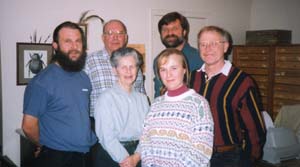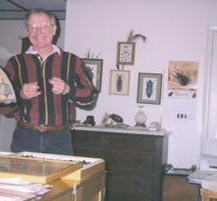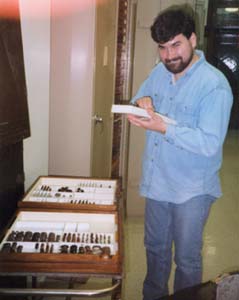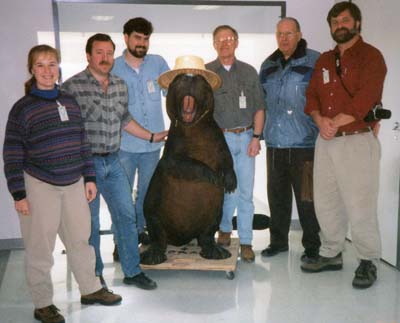
. |
.
Collections
Research in Ottawa, Canada
15-22 March 1998
Andrew Smith
|
| . |
Team
Scarab working on the NSF-funded project "Monography,
phylogenetics, and developing expertise in New World pleurostrict
scarab beetles" recently embarked on our first trip as
a group to study the major scarab collections in Ottawa, Ontario.
Brett Ratcliffe, Mary Liz Jameson, and Andrew Smith traveled
from Lincoln, Nebraska, and collaborator Art Evans traveled
from Los Angeles, California. The trip to Ottawa afforded us
the opportunity to discuss our research objectives with several
prominent scarab systematists: Henry Howden, Bruce Gill, and
François Génier. In addition, Ottawa is the home
to five major collections, including the Canadian Museum of
Nature, the Canadian National Museum, the Henry and Anne Howden
collection, the Bruce Gill collection, and the François
Génier collection. All of these collections have a strong
Neotropical component and contain numerous specimens important
to our research. Another attraction was the recent acquisition
of the Antonio Martínez collection by Henry Howden.
Martínez was a renowned scarab taxonomist from Argentina
who collected extensively throughout South America. While in
Ottawa, we enjoyed the fine company of many colleagues, excellent
scarab collections, a variety of Canadian beer, French-Canadian
cuisine (poutine!), and the Canadian accent (eh?).
|
|
| . |
|
|
......
|
Scarab
workers infiltrated by weevilist. Bruce Gill, Henry and Anne
Howden,
Mary Liz Jameson, Art Evans, and Brett Ratcliffe at the
Howden home. .
|
...... |
|
...... |
| When
the scarab PEET team arrived in Ottawa, we were graciously received
by Henry and Anne Howden. Henry Howden is acclaimed for his taxonomic
work on many different groups of scarab beetles. He is arguably
the most prominent scarab taxonomist of this century. Anne Howden
is a eminent weevil taxonomist. It didn't take long before we
were pouring through the specimens in the Howden's collection.
The Howdens have one of the most complete collection of Neotropical
scarabs in the world. It has been created through decades of
field work and augmented by the recently acquired Martínez
collection. |
| . |
.
. |
|
 |
Ottawa from the Peace Tower on
Parliament Hill. |
|
Mary Liz Jameson and Andrew Smith looking at the Rutelinae in
the Howden collection. |
. |
|
|
| ___________________________________________________________________________________ |
| . |
|
|
Bob Anderson (one of
the world's leading weevil experts) and François Génier
(an expert on dung beetle systematics) were our hosts at the Canadian
Museum of Nature. The collection has been expertly curated by François
Génier, the Collection Manager. The donations of Henry and
Anne Howden have greatly enhanced this museum and its insect collections.
The Henry and Anne Howden collection will eventually be incorporated
into that of the Museum of Nature. When incorporation of the Howden's
collection is complete, the Canadian Museum of Nature collection
will have one of the largest and most complete scarab collections
in the world. |
. |
|
|
|
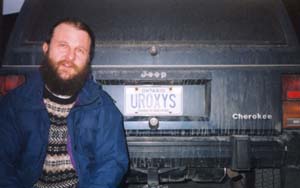 |
Brett Ratcliffe examining a drawer
of Henry's Dynastinae.
.
|
|
Bruce Gill with his license plate of a favorite genus of dung
beetle. But is thatUroxys bait dribbling down the back of his
Jeep?
|
. |
|
|
At the Canadian National Collection (Agriculture
Canada), we were hosted by Bruce Gill (an expert in dung beetle
systematics), Ales Smetana, Yves Bousquet, and Don Bright. The
Canadian National Collection contains specimens collected by the
numerous coleopterists who have worked for the institute over the
years. The scarab collection is extensive and contains many specimens
useful for our PEET project. |
| . |
|
|
| ___________________________________________________________________________________ |
. |
|
|
While in Ottawa, Brett Ratcliffe gave a talk at the
Ottawa Entomology Club on the recently completed survey of the
Dynastinae of Panama and Costa Rica. This was attended by approximately
30 entomologists. Brett was given an elaborate, object-guided introduction
by Bruce Gill (a budding late night show host?) and was provided
a beetle robot necklace for good luck during his talk. |
| . |
|
|
|
|
|
Andrew Smith sorts unidentified scarabs at the Canadian National
Collection.
|
|
Team Scarab: Mary Liz Jameson, François Génier,
Andrew Smith, Billy the Giant Beaver, Brett Ratcliffe, Henry
Howden, and Art Evans.
|
. |
|
|
| ___________________________________________________________________________________
.
|
| . |
|
|
From Ottawa, Brett, Mary Liz,
and Andrew traveled to the Marine Biological Laboratory at Woods
Hole, Massachusetts where they participated in an NSF-funded
workshop for recipients of PEET grants and their students. |
| . |
|
|
|
|



